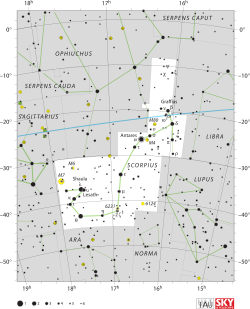Tau Scorpii
| Observation data Epoch J2000 Equinox J2000 |
|
|---|---|
| Constellation | Scorpius |
| Right ascension | 16h 35m 52.95285s |
| Declination | −28° 12′ 57.6615″ |
| Apparent magnitude (V) | +2.82 |
| Characteristics | |
| Spectral type | B0.2 V |
| U−B color index | −1.039 |
| B−V color index | −0.252 |
| Astrometry | |
| Radial velocity (Rv) | +2.0 km/s |
| Proper motion (μ) |
RA: −9.89 mas/yr Dec.: −22.83 mas/yr |
| Parallax (π) | 6.88 ± 0.53mas |
| Distance | 470 ± 40 ly (150 ± 10 pc) |
| Absolute magnitude (MV) | −4.2 |
| Details | |
| Mass | 15.0 ± 0.1, M☉ |
| Radius | 6.5 R☉ |
| Luminosity | 18,000, 20,400 L☉ |
| Surface gravity (log g) | 4.24 cgs |
| Temperature | 31,440, 29,850 K |
| Metallicity [Fe/H] | −0.14 dex |
| Rotation | 41 days |
| Rotational velocity (v sin i) | 24 km/s |
| Age | 5.7 ± 1.0,5 Myr |
| Other designations | |
Tau Scorpii is a star in the southern zodiac constellation of Scorpius. It has the traditional name Alniyat or Al Niyat, which it shares with σ Scorpii. The name derives from the Arabic النياط an-niyāţ meaning "the arteries". The apparent visual magnitude of Tau Scorpii is +2.8, while parallax measurements yield a distance estimate of roughly 470 light-years (150 parsecs) from Earth.
Compared to the Sun, Tau Scorpii is a massive OB star with 15 times the Sun's mass and more than six times the radius of the Sun. It is radiating about 18,000 times the Sun's luminosity from its outer envelope at an effective temperature of 31,440 K. This gives it the blue-white hue characteristic of B-type stars. As yet there is no evidence of a companion in orbit around τ Sco. It is a magnetic star whose surface magnetic field was mapped by means of Zeeman–Doppler imaging. Tau Scorpii is rotating relatively slowly with a period of 41 days.
The spectrum of this star shows triply ionized oxygen (O IV) that is being generated by X-rays and the Auger ionization effect. Observations with the ROSAT space telescope showed it has a higher energy (harder) X-ray spectrum than is usual for B0 V stars. Over the energy range 0.8–1.2 keV, its X-ray luminosity is Lx = 1.8 × 1031 erg s−1 with a large Lx to Lbol of log Lx/Lbol = –6.53 from ASCA measurements. ROSAT measurements showed a log Lx/Lbol ≃ –5.93 for the range 0.1-2.4 keV. The hard component of the X-ray spectrum from τ Sco as studied with XMM-Newton supports the presence of in-falling clumps of plasma in τ Sco.
...
Wikipedia

